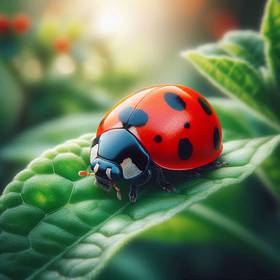Size and Shape Comparison
While both Asian Lady Beetles (Harmonia axyridis) and native ladybugs (Coccinella septempunctata) are roughly the same size, ranging from 5-8 millimeters long, their appearance can be quite different. Asian Lady Beetles are highly variable in color, ranging from orange to red, with black markings, often with white or yellow markings on the pronotum (shield behind the head). Their shape is more rounded, almost like a dome.
In contrast, native ladybugs are typically red with three black spots on each wing cover and one in the center, totaling seven. They are often described as having a "domed" appearance, but with a slightly more pointed or elongated shape compared to the Asian Lady Beetle.
In contrast, native ladybugs are typically red with three black spots on each wing cover and one in the center, totaling seven. They are often described as having a "domed" appearance, but with a slightly more pointed or elongated shape compared to the Asian Lady Beetle.
Color Variations and Patterns
While both Asian Lady Beetles and native ladybugs come in a variety of colors, they have some key differences. Asian Lady Beetles are highly variable, ranging from bright orange to red, with black markings. They often have white or yellow markings on the pronotum (shield behind the head).
Native ladybugs, like the Seven-spotted Ladybug, are typically red with three black spots on each wing cover and one in the center, totaling seven. The Asian Lady Beetle is more likely to have a more rounded, dome-like shape while native ladybugs are often more elongated. Both are about 5-8 millimeters long.
Native ladybugs, like the Seven-spotted Ladybug, are typically red with three black spots on each wing cover and one in the center, totaling seven. The Asian Lady Beetle is more likely to have a more rounded, dome-like shape while native ladybugs are often more elongated. Both are about 5-8 millimeters long.
Distinctive Marking Identification
Distinguishing Asian Lady Beetles from native ladybugs is important, especially if you're concerned about bites. Asian Lady Beetles are highly variable in color, ranging from orange to red with black markings.
They often have white or yellow markings on the pronotum (shield behind the head). Native ladybugs like the Seven-spotted Ladybug are typically red with three black spots on each wing cover and one in the center, totaling seven. Both are around 5-8 millimeters long.
They often have white or yellow markings on the pronotum (shield behind the head). Native ladybugs like the Seven-spotted Ladybug are typically red with three black spots on each wing cover and one in the center, totaling seven. Both are around 5-8 millimeters long.



